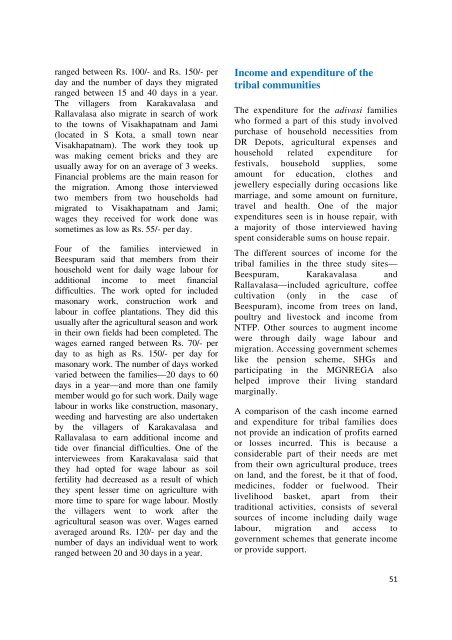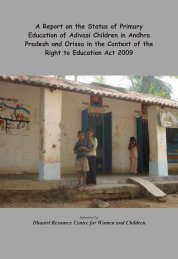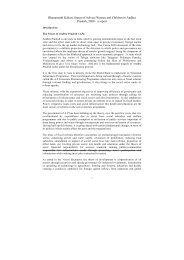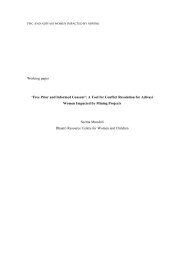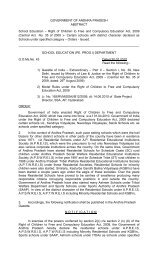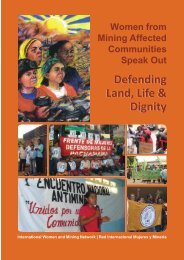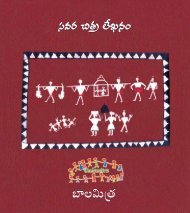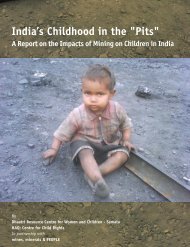emaining had worked anywhere betweenseven and 20 days in the whole year. InKarakavalasa village, am<strong>on</strong>g the familiesinterviewed, <strong>on</strong>e job card holder hadworked for 25 days and another for 20 days;the rest had worked anywhere between 6days and 18 days. In the case <str<strong>on</strong>g>of</str<strong>on</strong>g> Rallavalasathe maximum number <str<strong>on</strong>g>of</str<strong>on</strong>g> days worked in theyear was 30 days (by four pers<strong>on</strong>s am<strong>on</strong>gfamilies interviewed) and two <str<strong>on</strong>g>of</str<strong>on</strong>g> the jobcard holders had worked for 25 days and<strong>on</strong>e for 24 days; the remaining job cardholders had worked between 6 days and 20days in the year. In Beespuram the dailywage paid were either Rs. 80/- or Rs. 100/-.In Rallavalasa and Karakavalasa the wagespaid were either Rs. 100/- per day or Rs.120/- per day. The kind <str<strong>on</strong>g>of</str<strong>on</strong>g> work undertaken,in Beespuram am<strong>on</strong>gst those interviewed,included bush cutting and weeding in c<str<strong>on</strong>g>of</str<strong>on</strong>g>feeplantati<strong>on</strong>, st<strong>on</strong>e-breaking, building bundsfor tank and digging a p<strong>on</strong>d. In the case <str<strong>on</strong>g>of</str<strong>on</strong>g>Karakavalasa and Rallavalasa, the kind <str<strong>on</strong>g>of</str<strong>on</strong>g>work included rock and c<strong>on</strong>tour bunding.In the tribal ITDAs the PDS is managedunder the supervisi<strong>on</strong> and c<strong>on</strong>trol <str<strong>on</strong>g>of</str<strong>on</strong>g> theProject Officer <str<strong>on</strong>g>of</str<strong>on</strong>g> the ITDA. The GCC takescare <str<strong>on</strong>g>of</str<strong>on</strong>g> the retail and wholesale distributi<strong>on</strong>.Essential food grains, as well as other items<str<strong>on</strong>g>of</str<strong>on</strong>g> everyday requirements (like potatoes,<strong>on</strong>i<strong>on</strong>s, soap, clothes, hair oil, spices, evencell ph<strong>on</strong>e recharge cards, plastic chairs,etc) are supplied to the adivasis through anetwork <str<strong>on</strong>g>of</str<strong>on</strong>g> 839 fair price shops also knownas DR Depots run by the GCC. In somecases the functi<strong>on</strong>ing <str<strong>on</strong>g>of</str<strong>on</strong>g> the DR Depots hasbeen handed over to SHGs, several <str<strong>on</strong>g>of</str<strong>on</strong>g> whichare women SHGs run entirely by women.Where no such depots are possible part-timedepots are set up by the GCC and mannedby adivasis and in the absence <str<strong>on</strong>g>of</str<strong>on</strong>g> both it isthe resp<strong>on</strong>sibility <str<strong>on</strong>g>of</str<strong>on</strong>g> the Project Officer <str<strong>on</strong>g>of</str<strong>on</strong>g>the ITDA to identify an individual to whomthe fair price shop is then entrusted. In thetribal areas it is specified that there shouldbe <strong>on</strong>e rati<strong>on</strong> ship for a populati<strong>on</strong> <str<strong>on</strong>g>of</str<strong>on</strong>g>thousand. Each DR Depot caters to 4–5villages. The GCC also maintains theMandal Level Stockist in the ITDA areas,that number 28 and stocks <str<strong>on</strong>g>of</str<strong>on</strong>g> commoditiesare stored here.DR Depots were accessed by intervieweesin all the three study sites for purchasinghousehold necessities like rice, oil, sugar,red gram and kerosene. Oni<strong>on</strong>, tea, soap,peas (dried) and pulses are also purchasedby a few <str<strong>on</strong>g>of</str<strong>on</strong>g> the interviewees. Kerosene ispurchased at Rs. 10/- per litre and 3–5 litreswere purchased in a m<strong>on</strong>th by <strong>on</strong>e family.Nearly 1 kg <str<strong>on</strong>g>of</str<strong>on</strong>g> <strong>on</strong>i<strong>on</strong>s were c<strong>on</strong>sumed insome households every m<strong>on</strong>th which waspurchased at a rate between Rs. 14/- and Rs.20/-. Most families c<strong>on</strong>sume about 20 kgeach m<strong>on</strong>th <str<strong>on</strong>g>of</str<strong>on</strong>g> rice, each kilo at a subsidisedprice <str<strong>on</strong>g>of</str<strong>on</strong>g> Rs. 2/- per kg. Larger familiesc<strong>on</strong>sume nearly 35 kg. Red gram, 1–2 kgare c<strong>on</strong>sumed by the family each m<strong>on</strong>th; theaverage price paid for is Rs. 70/- per kg. Insome cases the interviewees said they hadpaid as low as Rs. 30/- or as high as Rs. 90/-per kg for red gram. Sugar, nearly 1 kg, isc<strong>on</strong>sumed m<strong>on</strong>thly by each family which ispurchased from the DR Depot for Rs. 15/-per kg. Cooking oil normally c<strong>on</strong>sumed is 1litre per m<strong>on</strong>th bought from the DR Depotfor about Rs. 50/- per litre. The number <str<strong>on</strong>g>of</str<strong>on</strong>g>items purchased from the DR Depots weremostly limited to those menti<strong>on</strong>ed above.Migrati<strong>on</strong> and daily wageAbout 20 members from the entire village<str<strong>on</strong>g>of</str<strong>on</strong>g> Beespuram migrate for a period <str<strong>on</strong>g>of</str<strong>on</strong>g> 15days to <strong>on</strong>e m<strong>on</strong>th or 50 days in a year tothe towns <str<strong>on</strong>g>of</str<strong>on</strong>g> Visakhapatnam or Anakapallesituated nearby and even to as far <str<strong>on</strong>g>of</str<strong>on</strong>g>f as thetown <str<strong>on</strong>g>of</str<strong>on</strong>g> Tirupathi. They take up machineryor road/soil work, mas<strong>on</strong>ary work orloading bricks to earn an income. The mainreas<strong>on</strong> for leaving their village is the lack <str<strong>on</strong>g>of</str<strong>on</strong>g>work in the village and the fact that they didnot earn much from daily wage labour.Am<strong>on</strong>g those interviewed four <str<strong>on</strong>g>of</str<strong>on</strong>g> thehouseholds had migrants, <strong>on</strong>e <str<strong>on</strong>g>of</str<strong>on</strong>g> whom wasa woman. Wage rates for the migrants50
anged between Rs. 100/- and Rs. 150/- perday and the number <str<strong>on</strong>g>of</str<strong>on</strong>g> days they migratedranged between 15 and 40 days in a year.The villagers from Karakavalasa andRallavalasa also migrate in search <str<strong>on</strong>g>of</str<strong>on</strong>g> workto the towns <str<strong>on</strong>g>of</str<strong>on</strong>g> Visakhapatnam and Jami(located in S Kota, a small town nearVisakhapatnam). The work they took upwas making cement bricks and they areusually away for <strong>on</strong> an average <str<strong>on</strong>g>of</str<strong>on</strong>g> 3 weeks.Financial problems are the main reas<strong>on</strong> forthe migrati<strong>on</strong>. Am<strong>on</strong>g those interviewedtwo members from two households hadmigrated to Visakhapatnam and Jami;wages they received for work d<strong>on</strong>e wassometimes as low as Rs. 55/- per day.Four <str<strong>on</strong>g>of</str<strong>on</strong>g> the families interviewed inBeespuram said that members from theirhousehold went for daily wage labour foradditi<strong>on</strong>al income to meet financialdifficulties. The work opted for includedmas<strong>on</strong>ary work, c<strong>on</strong>structi<strong>on</strong> work andlabour in c<str<strong>on</strong>g>of</str<strong>on</strong>g>fee plantati<strong>on</strong>s. They did thisusually after the agricultural seas<strong>on</strong> and workin their own fields had been completed. Thewages earned ranged between Rs. 70/- perday to as high as Rs. 150/- per day formas<strong>on</strong>ary work. The number <str<strong>on</strong>g>of</str<strong>on</strong>g> days workedvaried between the families—20 days to 60days in a year—and more than <strong>on</strong>e familymember would go for such work. Daily wagelabour in works like c<strong>on</strong>structi<strong>on</strong>, mas<strong>on</strong>ary,weeding and harvesting are also undertakenby the villagers <str<strong>on</strong>g>of</str<strong>on</strong>g> Karakavalasa andRallavalasa to earn additi<strong>on</strong>al income andtide over financial difficulties. One <str<strong>on</strong>g>of</str<strong>on</strong>g> theinterviewees from Karakavalasa said thatthey had opted for wage labour as soilfertility had decreased as a result <str<strong>on</strong>g>of</str<strong>on</strong>g> whichthey spent lesser time <strong>on</strong> agriculture withmore time to spare for wage labour. Mostlythe villagers went to work after theagricultural seas<strong>on</strong> was over. Wages earnedaveraged around Rs. 120/- per day and thenumber <str<strong>on</strong>g>of</str<strong>on</strong>g> days an individual went to workranged between 20 and 30 days in a year.Income and expenditure <str<strong>on</strong>g>of</str<strong>on</strong>g> thetribal communitiesThe expenditure for the adivasi familieswho formed a part <str<strong>on</strong>g>of</str<strong>on</strong>g> this study involvedpurchase <str<strong>on</strong>g>of</str<strong>on</strong>g> household necessities fromDR Depots, agricultural expenses andhousehold related expenditure forfestivals, household supplies, someamount for educati<strong>on</strong>, clothes andjewellery especially during occasi<strong>on</strong>s likemarriage, and some amount <strong>on</strong> furniture,travel and health. One <str<strong>on</strong>g>of</str<strong>on</strong>g> the majorexpenditures seen is in house repair, witha majority <str<strong>on</strong>g>of</str<strong>on</strong>g> those interviewed havingspent c<strong>on</strong>siderable sums <strong>on</strong> house repair.The different sources <str<strong>on</strong>g>of</str<strong>on</strong>g> income for thetribal families in the three study sites—Beespuram, Karakavalasa andRallavalasa—included agriculture, c<str<strong>on</strong>g>of</str<strong>on</strong>g>feecultivati<strong>on</strong> (<strong>on</strong>ly in the case <str<strong>on</strong>g>of</str<strong>on</strong>g>Beespuram), income from trees <strong>on</strong> land,poultry and livestock and income fromNTFP. Other sources to augment incomewere through daily wage labour andmigrati<strong>on</strong>. Accessing government schemeslike the pensi<strong>on</strong> scheme, SHGs andparticipating in the MGNREGA alsohelped improve their living standardmarginally.A comparis<strong>on</strong> <str<strong>on</strong>g>of</str<strong>on</strong>g> the cash income earnedand expenditure for tribal families doesnot provide an indicati<strong>on</strong> <str<strong>on</strong>g>of</str<strong>on</strong>g> pr<str<strong>on</strong>g>of</str<strong>on</strong>g>its earnedor losses incurred. This is because ac<strong>on</strong>siderable part <str<strong>on</strong>g>of</str<strong>on</strong>g> their needs are metfrom their own agricultural produce, trees<strong>on</strong> land, and the forest, be it that <str<strong>on</strong>g>of</str<strong>on</strong>g> food,medicines, fodder or fuelwood. Theirlivelihood basket, apart from theirtraditi<strong>on</strong>al activities, c<strong>on</strong>sists <str<strong>on</strong>g>of</str<strong>on</strong>g> severalsources <str<strong>on</strong>g>of</str<strong>on</strong>g> income including daily wagelabour, migrati<strong>on</strong> and access togovernment schemes that generate incomeor provide support.51


